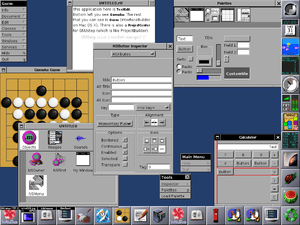GNUstep
GNUstep is a free software implementation of the Cocoa (formerly OpenStep) Objective-C frameworks, widget toolkit, and application development tools for Unix-like operating systems and Microsoft Windows. It is part of the GNU Project.
 | |
 GNUstep screenshot, showing Window Maker and a variety of applications developed with the GNUstep libraries, including a gomoku game, calculator, and TextEdit.[2] | |
| Developer(s) | GNUstep Developers |
|---|---|
| Stable release | make 2.8.0, base 1.27.0, gui 0.28, back 0.28
/ April 5, 2020 |
| Preview release | only in the SVN software repository
|
| Written in | Objective-C |
| Operating system | Cross-platform |
| Type | Widget toolkit |
| License | GNU General Public License for the applications GNU Lesser General Public License for the libraries. |
| Website | www |
GNUstep features a cross-platform, object-oriented IDE. Apart from the default Objective-C interface, GNUstep also has bindings for Java, Ruby,[3] GNU Guile and Scheme.[4] The GNUstep developers track some additions to Apple's Cocoa to remain compatible. The roots of the GNUstep application interface are the same as the roots of Cocoa: NeXTSTEP and OpenStep. GNUstep thus predates Cocoa, which emerged when Apple acquired NeXT's technology and incorporated it into the development of the original Mac OS X, while GNUstep was initially an effort by GNU developers to replicate the technically ambitious NeXTSTEP's programmer-friendly features.
History
GNUstep began when Paul Kunz and others at Stanford Linear Accelerator Center wanted to port HippoDraw from NeXTSTEP to another platform. Instead of rewriting HippoDraw from scratch and reusing only the application design, they decided to rewrite the NeXTSTEP object layer on which the application depended. This was the first version of libobjcX. It enabled them to port HippoDraw to Unix systems running the X Window System without changing a single line of their application source. After the OpenStep specification was released to the public in 1994, they decided to write a new objcX which would adhere to the new APIs. The software would become known as "GNUstep".[5]
Software architecture

Rendering
GNUstep contains a set of graphical control elements written in the Objective-C programming language.
The graphical user interface (GUI) of GNUMail is composed of graphics control elements. GNUMail has to interact with the windowing system, e.g. X11 or Wayland, and its graphical user interface has to be rendered. GNUstep's backend provides a small set of functions used by the user interface library to interface to the actual windowing system. It also has a rendering engine which emulates common Postscript functions. The package gnustep-back provides the following backends:
- cairo – default backend using the Cairo 2D graphics library.
- winlib – default backend on Microsoft Windows systems. Cairo and Windows API variants.
- art – old (deprecated) backend on unix-like systems. Uses the vector-based PostScriptlike 2d graphics library Libart.
- xlib – old (deprecated) X11 backend.
Paradigms
GNUstep inherits some design principles proposed in OPENSTEP (GNUstep predates Cocoa, but Cocoa is based on OPENSTEP) as well as the Objective-C language.
- Model–view–controller paradigm
- Target–action
- Drag-and-drop
- Delegation
- Message forwarding (through NSInvocation)
Other interfaces
In addition to the Objective-C interface, some small projects under the GNUstep umbrella implement other APIs from Apple:
- The Boron library aims to implement the Carbon API. It is very incomplete.[6]
- The CoreBase library is designed to be compatible with Core Foundation. It is not complete enough to for the Base (Foundation Kit) component to simply be a wrapper around it.[7]
- The QuartzCore library implements Core Animation APIs.[8] The Opal library implements Quartz 2D.
As of February 2020, there are no projects that builds the Swift programming language against the GNUstep Objective-C environment.
Applications
Here are some examples of applications written for or ported to GNUstep.[9]
Written from scratch
- Addresses, an address/contacts manager
- Étoilé, a desktop environment
- GNUMail, an e-mail client
- GNUstep Database Library 2, an Enterprise Objects Framework clone
- GNUstepWeb, an application server compatible with WebObjects 4.x
- Gorm, an interface builder
- GWorkspace, a workspace and file manager
- Grr, an RSS feed reader
- Oolite, a clone of Elite, a space simulation game with trading components
- PRICE, imaging application
- ProjectCenter, the Project Builder or Xcode equivalent.
- TalkSoup, an IRC client
- Terminal
- Zipper, a file archiver tool
Ported from NeXTSTEP, OPENSTEP, or macOS
Forks of GNUstep
- Universal Windows Platform, which includes a WinObjC suite consisting of various parts of GNUstep and Microsoft's own implementations of things like the Cocoa Touch API.[10]
Class capabilities
Foundation Kit
The Foundation Kit provides basic classes such as wrapper classes and data structure classes.
- strings
- collections (arrays, sets, dictionaries) and enumerators
- file management
- object archiving
- advanced date manipulation
- distributed objects and inter-process communication
- URL handling
- notifications (and distributed notifications)
- easy multi-threading
- timers
- locks
- exception handling
Application Kit
The Application Kit provides classes oriented around graphical user interface capabilities.
- user interface elements (table views, browsers, matrices, scroll views)
- graphics (WYSIWYG, postscript-like graphics, bezier paths, image handling with multiple representations, graphical contexts)
- color management (calibrated vs. device colors; CMYK, RGB, HSB, gray and named color representations; alpha transparency)
- text system features: rich text format, text attachments, layout manager, typesetter, rules, paragraph styles, font management, spelling
- document management
- printing features: print operations, print panel and page layout
- help manager
- pasteboard (aka clip board) services
- spell checker
- workspace bindings for applications
- drag and drop operations
- services sharing among applications
See also
- Darling (software), a compatibility layer that relies on GNUstep
- Étoilé, GNUstep-based desktop environment
- GNUstep Renaissance, framework for XML description of portable GNUstep/Mac OS X user interfaces
- Miller Columns, the method of file tree browsing the GWorkspace File Viewer uses
- Property list, often used file format to store user settings
- StepTalk, Scripting framework
- Window Maker, a window manager designed to emulate the NeXT GUI as part of the wider GNUstep project
References
- Ported from NeXTSTEP. Recent builds, when built with libobjc2, can use a newer version ported from Mac OS X Snow Leopard
- Ported from NeXTSTEP. Recent builds, when built with libobjc2, can use a newer version ported from Mac OS X Snow Leopard
- "GNUstep Developer Tools - RIGS". www.gnustep.org. Retrieved 10 April 2018.
- GScheme Archived 2005-12-18 at the Wayback Machine
- "GNUstep History". gnustep.made-it.com. Retrieved 10 April 2018.
- "gnustep/libs-boron: Boron is the atom that comes before carbon". GitHub. GNUstep. 23 March 2019.
- "gnustep/libs-corebase". GNUstep. 19 November 2019.
- "gnustep/libs-quartzcore". GNUstep. 11 December 2019.
- "Category:Applications - GNUstepWiki". wiki.gnustep.org. Retrieved 10 April 2018.
- "GNUstep Objective-C Runtime 2.0". GitHub.
Note: Microsoft's WinObjC project contains a friendly fork of this library that includes a work around for the incremental linking issue.
External links
| Wikimedia Commons has media related to GNUstep. |
- GNUstep.org project homepage
- GNUstep Applications and Developer Tutorials
- The GNUstep Application Project
- A 2003 interview with GNUstep developer Nicola Pero Archived 2007-01-07 at the Wayback Machine
- FLOSS Weekly Interview with Gregory Casamento and Riccardo Mottola from GNUstep
- GNUstep on Debian, FreeBSD, MacPorts
- NEXTSPACE desktop environment, based on GNUstep